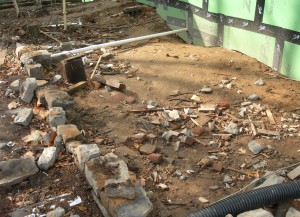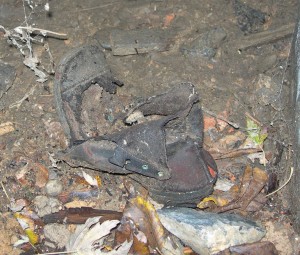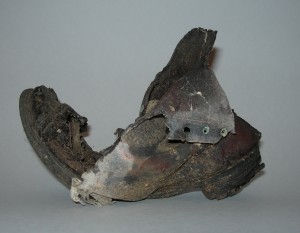As we completed the work on the removal of the rear additions, the floorboard and floor joists were taken away to expose the ground surface beneath. This ground surface had formerly served as the floor of a crawl space which was only accessible to small animals and burrowing groundhogs. (See photo below.) The groundhogs may prove to be particularly problematic as the archaeological excavations of the subsurface begin next spring. Even though we see no evidence that they are still active in the area behind the house, it is obvious that in certain places their burrowing has muddled the strata. The jumble of broken ceramic pieces (dating from the eighteenth through the twentieth centuries) around the openings of their holes tells us that they have definitely disturbed some of the evidence.
Among the broken ceramic shards and other debris found on the surface behind the log side of the structure was a badly deteriorated boy’s lace-up boot. (See photos below.) It was found not far from an opening formerly cut in the floor for the base of a cabinet that had supported a brick chimney stack that vented stoves. This old boot would be a relatively insignificant piece of junk if it were not for the fact that it seems to fit a pattern associated with a well-documented folk tradition. In Briton, western Europe, and (mostly) in the eastern United States and Canada, workers performing demolition jobs in old buildings have discovered purposefully concealed shoes and boots dating from the times of earlier construction campaigns or to later alterations in the structures. They have been found concealed inside chimneys, under floorboards, in walls, and in other spaces that were sealed off from use and view. One concealed shoe (a lady’s high heeled pump from circa 1790) was recently discovered in a sealed-off space under a stairway at historic Clermont Farm in Berryville, Virginia, just 17 miles away. Bob Stieg, CEO of Clermont Farm, shared an article with us on this subject that was published in 1996 by Costume magazine. It was authored by June Swann, of the Northampton Museum in England, an institution with the largest curated collection of historical footwear in the world. Ms. Swann recounted how at the time she was writing, they had documented as many as 1,550 shoes and boots discovered concealed in historic structures in Western Europe and North America. All of the evidence points to a relationship with ancient customs of sacrificing objects to ensure good fortune. Thus, our concealed boot may have served as a good luck charm to whoever deposited it under that floor during the late 1800s or early 1900s, the period when the Argenbright family owned that side of the house. Determining the date of the boot may tell us more. As always, we will keep you posted!



